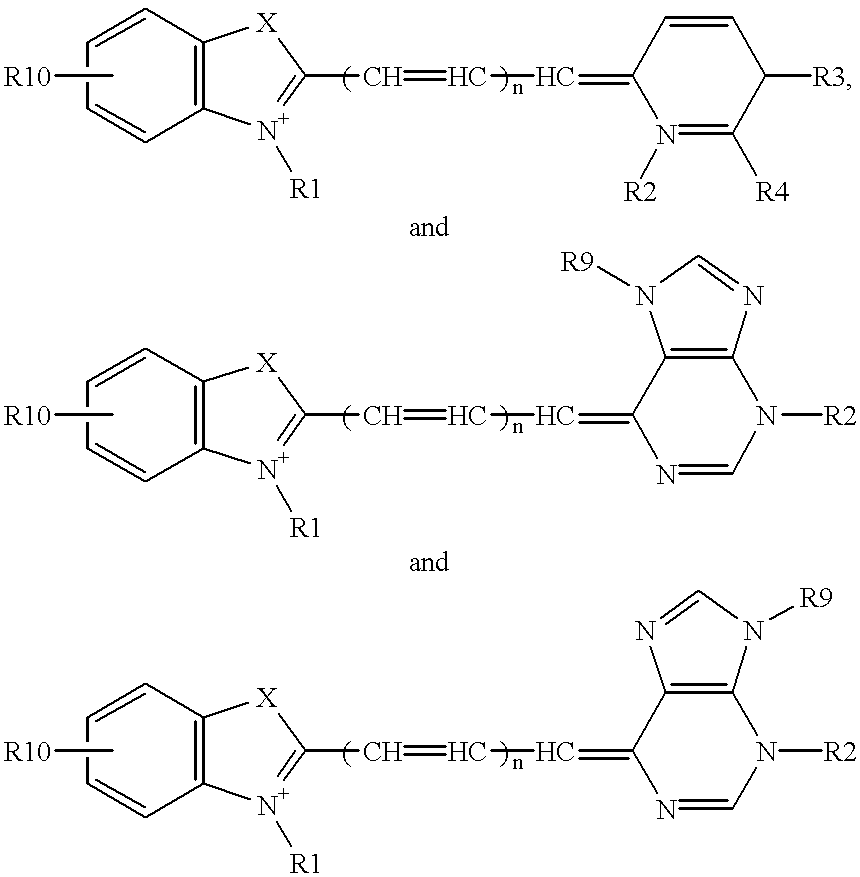Probe for analysis of target nucleic acids
a nucleic acid and target technology, applied in the direction of material testing goods, biochemistry apparatus and processes, sugar derivatives, etc., can solve the problems of inability to perform in vivo and real time detection, the most time-consuming and critical step, and the application of sophisticated instruments is limited to specialized laboratories
- Summary
- Abstract
- Description
- Claims
- Application Information
AI Technical Summary
Benefits of technology
Problems solved by technology
Method used
Image
Examples
example 1
Synthesized RG:s
Example 2
Probes Synthesized
example 3
Synthesis of a Succinimidyl Ester of Thiazole Orange (TO-5-S)
The synthesis was made in four steps.
N-methyl-2-methylbenzothiazole p-toluene sulphonate (I, FIG. 7) p-toluen methylsulphonate (3.5 g, 18.8 mole) was slowly added to 2.1 g (14.0 mole) 2-methyl benzothiazol in ethanol (10 ml). The mixture was refluxed for three hours and then stirred at room temperature for 15 hours. The solvent was evaporated and the product re-crystallized in methanol / acetone.
Yield: 4.2 g, 12.6 mmol, 91%.
N-(carboxypentyl) quinoline bromide (II, FIG. 7)
Chinolin (5.2 g, 40 mmol) and 6-bromo-hexanicacid (7.8 g, 40 mmol) was added to 30 ml acetonitrile. The mixture was refluxed under nitrogen atmosphere for three hours and then stirred for 15 hours at room temperature. 50 ml acetone was added and the solution was stirred for further 1 hour. The white precipitate was filtered, washed with acetone (2*10 ml) and dried.
Yield: 8.4 g, 26 mmol, 65%.
N-carboxypentyl-4-[(3-methyl-2(3H)-benzothiazolyliden)methyl]-quinol...
example 4
Solution Synthesis of a PNA Probe (PP10-CTT-TO) and Characterization Thereof
38 nmol of a PNA, equipped with an amino group, of the sequence `TTTTCTTCTT-CO--(CH.sub.2).sub.5 -(SEQ ID NO:10)NH.sub.2 ` was dissolved in 10 .mu.l H.sub.2 O, and 31 .mu.l of 500 mM Na.sub.3 BO.sub.3 buffer, and 10 .mu.l of dioxane was added. The reaction was started by addition of 140 nmol TO-5-S (in DMSO) in two aliquots of 2 .mu.l (with 5 minutes stirring in between), where after the reaction mixture was placed at 37.degree. C. for four hours. After cooling to 25.degree. C. 10 .mu.l of acetonitrile was added. The product was purified by HPLC, using a reversed phase C-18 column (Waters, symmetry C18 3.9.times.150 mm) in a gradient system (LKB 2249), and monitoring absorption at 260 nm (LKB 2151). The gradient used was a mixture of acetonitrile and water with 0.01-0.1% v / v trifluoroacetic acid. The flow was 1 ml / min and the gradient was 95-60% H.sub.2 O, 20 min., 60-0% H.sub.2 O, 5 min. Probe and excess TO...
PUM
| Property | Measurement | Unit |
|---|---|---|
| Fraction | aaaaa | aaaaa |
| Molar density | aaaaa | aaaaa |
| Molar density | aaaaa | aaaaa |
Abstract
Description
Claims
Application Information
 Login to View More
Login to View More - R&D
- Intellectual Property
- Life Sciences
- Materials
- Tech Scout
- Unparalleled Data Quality
- Higher Quality Content
- 60% Fewer Hallucinations
Browse by: Latest US Patents, China's latest patents, Technical Efficacy Thesaurus, Application Domain, Technology Topic, Popular Technical Reports.
© 2025 PatSnap. All rights reserved.Legal|Privacy policy|Modern Slavery Act Transparency Statement|Sitemap|About US| Contact US: help@patsnap.com



